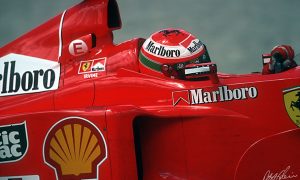TO WHAT PURPOSE?
These slits serve to isolate the air flowing under the car so the diffuser can work more efficiently.
As is well known, wheel rotation disrupts the aerodynamic operation of the car: this phenomenon is known as “tyre squirt”. At the rear of the car, the turbulent and low-energy flow of the tyre squirt penetrates, at the sides, into the diffuser and hinders its work. The phenomenon is even more penalizing since the car set-up is pitched forward. In addition, the ambient air – high pressure – tries to rush under the floor, attracted by the depression that is created there.
To contain this double intrusion, aerodynamicists had the idea to place various cuts in the floor: either notches just in front of the rear wheels, or slits parallel to the edge of the floor. The rationale is the same as with the floor slots ahead of the rear wheels, i.e. to allow high-pressure air above the floor to go under the car in order to seal the edges of the diffuser.
How does it work? Where low-pressure and high-pressure air meet a vortex is generated; a vortex which acts as a wall to protect the diffuser from the dirty wake of the rotating rear tyres.
Sealing the diffuser’s edges is all the more important this year with teams running a higher rake angle on their 2018-spec cars, which is especially true for the SF71H.







